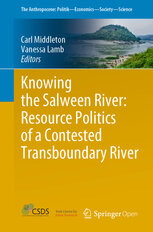JOURNAL ARTICLE: The Salween River as a transboundary commons: Fragmented collective action, hybrid governance and power
/Publication date: 28 July 2020
Publication: Asia Pacific Viewpoint
Authors: Diana Suhardiman, Carl Middleton
Abstract:
Viewing the Salween River as a transboundary commons, this paper illustrates how diverse state and non‐state actors and institutions in hybrid and multi‐scaled networks have influenced water governance in general, and large dam decision‐making processes in particular. Putting power relations at the centre of this analysis and drawing on the conceptual lenses of hybrid governance and critical institutionalism, we show the complexity of the fragmented processes through which decisions have been arrived at, and their implications. In the context of highly asymmetrical power relations throughout the basin, and the absence of an intergovernmental agreement to date, we argue that hybrid networks of state and non‐state actors could be strategically engaged to connect parallel and fragmented decision‐making landscapes with a goal of inclusively institutionalising the transboundary commons and maintaining connected local commons throughout the basin, foregrounding a concern for ecological and social justice.
Keywords: China, large hydropower dams, limited statehood, Myanmar, Thailand, water governance
See the article here.










